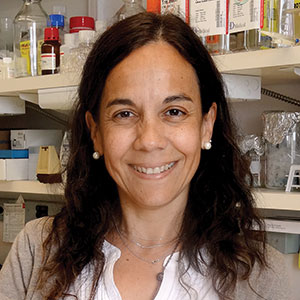Maria Laura Allende, Ph.D.

Professional Experience
- Staff Scientist, NIDDK, NIH, 2005–present
- Research Fellow, NIDDK, NIH, 1999–2005
- Postdoctoral Research Associate, School of Dentistry, University of Louisville, 1996–1999
- Postdoctoral Fellow, School of Chemical Sciences, National University of Cordoba, Argentina, 1995–1996
- Ph.D. Fellow, School of Chemical Sciences, National University of Cordoba, Argentina, 1991–1995
- Instructor, School of Chemical Sciences, National University of Cordoba, Argentina, 1990-1996
- Ph.D., School of Chemical Sciences, National University of Cordoba, Argentina, 1995
- Chemist, School of Chemical Sciences, National University of Cordoba, Argentina, 1985-1989
Research Goal
I am interested in understanding the role of sphingolipids in physiology and during disease processes.
Current Research
The goal of my research is the study of the function of sphingolipids, a class of lipids that are essential constituents of the cell membranes, and signaling molecules. They are abundant in the nervous system, adipose tissue and in the liver. They are involved in processes such as proliferation, nerve conduction, skin permeability and lymphocyte migration. Overall, I am involved in projects aimed at understanding the role of sphingolipids during development and in the process of disease using mouse models and cell lines in vitro. We are studying the functions of sphingolipids by inducing genetic modifications on the genes involved in sphingolipid synthesis and degradation -either by deleting a gene, adding it to the genome, or altering its regulatory elements- and further analyzing the resulting phenotypes. This knowledge can be extrapolated to human physiology.
Applying our Research
Our research on basic areas of the biology of sphingolipids could potentially be clinically relevant in many areas of human disease, including autoimmunity and inflammatory processes, obesity, and obesity-related complications such as type 2 diabetes and atherosclerosis and neurodegenerative disorders.
Need for Further Study
Our research focus on the discovery of novel areas of the physiology regulated by sphingolipids, with the ultimate goal of developing potential therapies to treat disorders in which these lipids are involved.
Select Publications
- Sialidase NEU3 action on GM1 ganglioside is neuroprotective in GM1 gangliosidosis.
- Allende ML, Lee YT, Byrnes C, Li C, Tuymetova G, Bakir JY, Nicoli ER, James VK, Brodbelt JS, Tifft CJ, Proia RL.
- J Lipid Res (2023 Dec) 64:100463. Abstract/Full Text
- SARS-CoV-2 ORF3a expression in brain disrupts the autophagy-lysosomal pathway, impairs sphingolipid homeostasis, and drives neuropathogenesis.
- Zhu H, Byrnes C, Lee YT, Tuymetova G, Duffy HBD, Bakir JY, Pettit SN, Angina J, Springer DA, Allende ML, Kono M, Proia RL.
- FASEB J (2023 May) 37:e22919. Abstract/Full Text
Research in Plain Language
My research focus on the use of in vivo and in vitro models to study the function of sphingolipids during development and disease. We use a genetic approach, by inducing modifications on the genes involved in sphingolipid synthesis and degradation.
